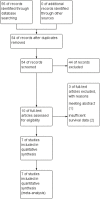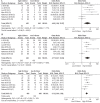A high plasma D-dimer level predicts poor prognosis in gynecological tumors in East Asia area: a systematic review and meta-analysis
- PMID: 28881667
- PMCID: PMC5584268
- DOI: 10.18632/oncotarget.17936
A high plasma D-dimer level predicts poor prognosis in gynecological tumors in East Asia area: a systematic review and meta-analysis
Abstract
High pre-treatment plasma D-dimer levels have been reported as a factor associated with a poor prognosis in different types of malignancies, including pancreatic, gastric, colorectal, lung, and nasopharyngeal carcinoma. Here, we performed a meta-analysis to determine the association of plasma D-dimer levels and long term survival in gynecological cancers, including ovarian, cervical and endometrial carcinoma. We searched all eligible publications in PubMed and Web of Science Databases up to August 2016. Primary outcomes, including overall survival (OS), disease-free survival and hazard ratios (HR) of were extracted and analyzed. Heterogeneity and publication bias were also assessed. A total of 7 eligible studies with 1112 cases were included in this study and all included studies are conducted in East Asia area. We found that gynecological cancer patients with high D-dimer demonstrates a much lower 5-year survival rate than those with low D-dimer levels (OR 4.12, 95% CI 3.04-5.58, P<0.00001). No significant heterogeneity is found (I2 = 10 %; P = 0.35). Importantly, pooled analysis showed that high plasma D-dimer levels are predictive of a shorter OS in gynecological cancers (HR 2.09, 95% CI 1.59-2.74). No heterogeneity is observed (I2=5%, P=0.39). Additionally, a subgroup analysis of ovarian cancer is conducted. In conclusion, this meta-analysis showed that a high plasma D-dimer level predicts poor prognosis in gynecological tumors.
Keywords: D-dimer; gynecological tumors; meta-analysis; prognosis.
Conflict of interest statement
CONFLICTS OF INTEREST The authors have no conflicts of interest to report.
Figures





References
-
- Siegel RL, Miller KD, Jemal A. Cancer statistics, 2016. CA Cancer J Clin. 2016;66:7–30. - PubMed
-
- Vergote IB, Jimeno A, Joly F, Katsaros D, Coens C, Despierre E, Marth C, Hall M, Steer CB, Colombo N, Lesoin A, Casado A, Reinthaller A, et al. Randomized phase III study of erlotinib versus observation in patients with no evidence of disease progression after first-line platin-based chemotherapy for ovarian carcinoma: a European Organisation for Research and Treatment of Cancer-Gynaecological Cancer Group, and Gynecologic Cancer Intergroup study. J Clin Oncol. 2014;32:320–326. - PubMed
-
- Adam SS, Key NS, Greenberg CS. D-dimer antigen: current concepts and future prospects. Blood. 2009;113:2878–2887. - PubMed
LinkOut - more resources
Full Text Sources
Other Literature Sources

